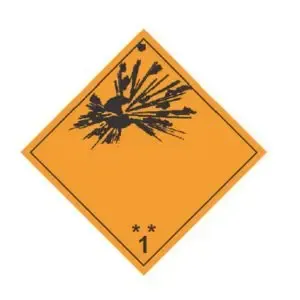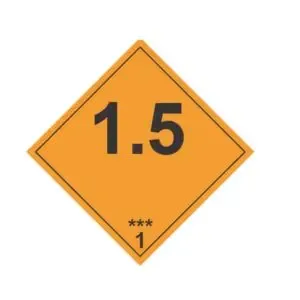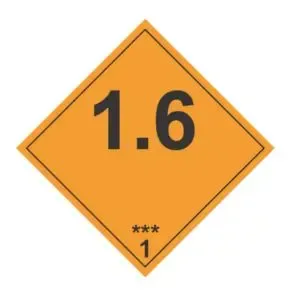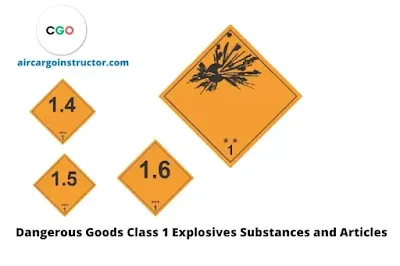Last Update 22-04-2023
Class 1 Dangerous Goods Explosives are substances, articles and substances, and articles which are manufactured with a view to producing a practical explosive or pyrotechnic effect. Class 1 is divided into six divisions which I will list later in this article.
The reason for regulated class 1 explosives is because explosive substances and articles can rapidly conflagrate or detonate as a consequence of chemical reaction that produces gases at temperatures, pressures, and speeds to cause catastrophic damage through force. Furthermore, the chemical reaction may produce otherwise hazardous amounts of heat, light, sound, gas, or smoke.
DG Class 1 is restricted class, that is, only those explosive substances and articles that are listed in the IATA Dangerous Goods List (IATA table 4.2) be accepted for transport.
In this article on Aviation Professional Website, you will learn about Class 1 Dangerous Goods Explosives sub-divisions and their hazard labels and IATA IMP Codes.
COMPATIBILITY GROUPS
Each explosive substance and article must be assigned to one of six divisions, and to one of thirteen compatibility groups that identify the kinds of explosive substances and articles that are deemed to be compatible.
I will define only 6 compatibility groups of 13 which are (B, C, D, E, G, and S).
Explosives Compatibility Group B
Compatibility group B classification code associated with the following sub-divisions 1.1B, 1.2B, and 1.4B.
Explosives Compatibility Group B is any article containing a primary explosive substance and not containing two or more effective protective features. Some articles, such as detonators for blasting, detonator assemblies for blasting and primers, and cap-type, are included even though they do not contain primary explosives.
Explosives Compatibility Group C
Compatibility group C classification code associated with the following sub-divisions 1.1C ,1.2C, 1.3C, and 1.4C.
Explosives Compatibility Group C is any propellant explosive substance or other deflagrating explosive substance or article containing a such explosive substance.
Explosives Compatibility Group D
Compatibility group D classification code associated with the following sub-divisions 1.1D, 1.2D, 1.4D, and 1.5D.
Explosives Compatibility Group D is any secondary detonating explosive substance or black powder or article containing a secondary detonating explosive substance, in each case without means of initiation and without a propelling charge, or article containing a primary explosive substance and containing two or more effective protective features.
Explosives Compatibility Group E
Compatibility group E classification code associated with the following sub-divisions 1.1E, 1.2E, and 1.4E.
Explosives Compatibility Group E is any article containing a secondary detonating explosive substance, without means of initiation, with a propelling charge (other than one containing a flammable liquid or gel or hypergolic liquids).
Explosives Compatibility Group G
Compatibility group E classification code associated with the following sub-divisions 1.1G, 1.2G, 1.3G, 1.4G
Explosives Compatibility Group G is any pyrotechnic substance, or article containing a pyrotechnic substance, or article containing both an explosive substance and an illuminating, incendiary, tear- or smoke-producing substance (other than a water-activated article or one containing white phosphorus, phosphides, a pyrophoric substance, a flammable liquid or gel, or hypergolic liquids).
Explosives Compatibility Group S
Compatibility group E classification code associated with the ONLY sub-division 1.4S.
Explosives Compatibility Group S is any substances or articles so packed or designed that any hazardous effects arising from accidental functioning are confined within the package unless the package has been degraded by fire, in which case all blast or projection effects are limited to the extent that they do not significantly hinder or prohibit firefighting or other emergency response in the immediate vicinity of the package.
After you got the meaning of the letters which were always written beside the class 1 sub-divisions number {i.e., 1.4S} which means the compatibility group [S].
Class 1 Explosives Sub-Divisions and Hazard Labels
Dangerous Goods of Class 1 explosives are assigned to one of six divisions, depending on the type of hazard they present:
Division 1.1: Substances and articles which have a mass explosion hazard
Division | IATA IMP CODE |
1.1 Forbidden Explosives | REX |
Example
TNT, UN 0209
L | J | G | F | E | D | C | B | A | Compatibility Group(s) |
Division 1.2: Substances and articles which have a projection hazard but not a mass explosion hazard
Division | IATA IMP CODE |
1.2 Forbidden Explosives | REX |
Example
MINES, UN 0209
L | K | J | H | G | F | E | D | C | B | Compatibility Group(s) |
Note: According to the transport of dangerous goods regulations, explosives divisions 1.1 and 1.2 are normally forbidden to be carried by air.
Division 1.3: Substances and articles which have a fire hazard and either a minor blast hazard or a minor projection hazard or both, but not a mass explosion hazard
Division | IATA IMP CODE |
1.3 Forbidden Explosives | REX |
1.3 C | RCX |
1.3 G | RGX |
 |
| ** Place for division and compatibility group |
Example
ROCKET MOTORS, UN 0186
L | K | J | H | G | F | C | Compatibility Group(s) |
Note : Only explosives in Class 1 dangerous goods- division 1.3, compatibility groups C and G are permitted on CAO - Cargo Aircraft only.
Division 1.4: Substances and articles which present no significant hazard
This division comprises articles and substances which present only a small hazard in the event of ignition or initiation during transport. The effects are largely confined to the package and no projection of fragments of appreciable size or range is to be expected. An external fire must not cause a virtually instantaneous explosion of almost the entire contents of the package.
Division | IATA IMP CODE |
1.4 B | RXB |
1.4 C | RXC |
1.4 D | RXD |
1.4 E | RXE |
1.4 G | RXG |
1.4 F Forbidden Explosives | REX |
1.4 S | RXS |
 |
| *** Place for compatibility group |
S | G | F | E | D | C | B | Compatibility Group(s) |
Example
FIREWORKS, UN 0337
Note 1: Only explosives in division 1.4, compatibility group S are permitted on a passenger aircraft.
Note 2: Only explosives in division 1.4, compatibility groups B, C, D, E, G, and S are permitted on CAO - Cargo Aircraft only.
Division 1.5: Very insensitive substances which have a mass explosion hazard
This division comprises substances that have a mass explosion hazard but are so insensitive that there is very little probability of initiation or of transition from burning to detonation under normal conditions of transport.
Division | IATA IMP CODE |
1.5 D Forbidden Explosives | REX |
 |
| *** Place for compatibility group |
Example
EXPLOSIVE, BLASTING, TYPE E, UN 0332
D | Compatibility Group |
Division 1.6: Extremely insensitive articles which do not have a mass explosion hazard
This division comprises articles that predominantly contain extremely insensitive substances and which demonstrate a negligible probability of accidental initiation or propagation.
Note. — The hazard from articles of Division 1.6 is limited to the explosion of a single article.
Division | IATA IMP CODE |
1.6 Forbidden Explosives | REX |
 |
| *** Place for compatibility group |
Example
EXPLOSIVE,BLASTING, TYPE E, UN 0332
Note: According to the transport of dangerous goods regulations, explosives divisions 1.5 and 1.6 are normally forbidden to be carried by air.
Watch this video which will give you examples of Class 1 dangerous goods:
